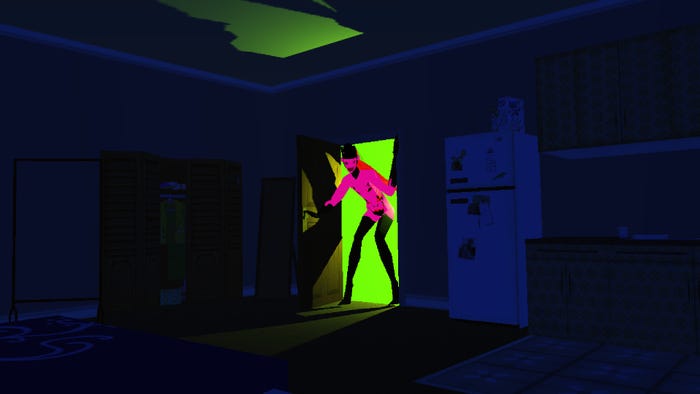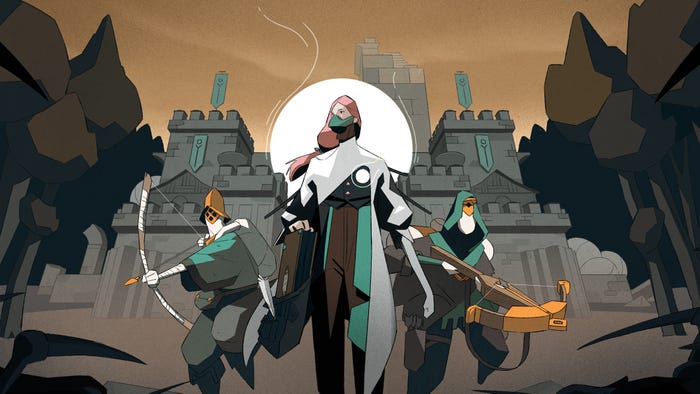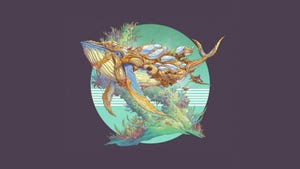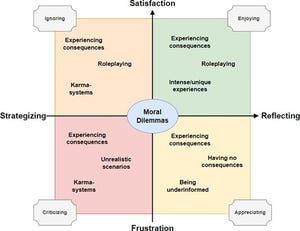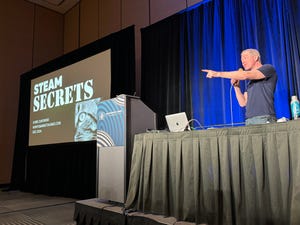
Featured Blog | This community-written post highlights the best of what the game industry has to offer. Read more like it on the Game Developer Blogs.
The Music of Jurassic World Primal Ops – Techniques for Game Composers
Game composer Winifred Phillips discusses music composition techniques for her award-winning score to the Jurassic World Primal Ops video game.

By Winifred Phillips | Contact | Follow
So happy you’ve joined us! I’m video game composer Winifred Phillips, and one of my latest projects is the musical score for the video game Jurassic World Primal Ops (listen to the score here). Over the past few months, I’ve been tremendously honored that my score for this game has garnered several award nominations, including Outstanding Original Score for Interactive Media from the Society of Composers & Lyricists, and Music of the Year from the Game Audio Network Guild. As a result, I’ve been asked numerous questions about how this score was created. With this in mind, I thought it might be helpful to write a brief article that includes a few of the guiding principles that shaped my work on this project.
I’ll be giving a lecture during the Game Developers Conference in San Francisco about my creative process, and I’ll be including some fine detail about how I planned and constructed this music. In this article, I’ll be focusing on a couple of broader concepts related to the role that music played in this project. But first, let’s briefly discuss the game itself.
Jurassic World Primal Ops
The Jurassic World Primal Ops video game casts players in the roles of expert dinosaur handlers working for the Department of Fish and Wildlife (DFW). In this capacity, players undertake missions to rescue dinosaurs from poachers, mercenaries, and other malevolent forces. The action of the game is set in various locales across North America following the calamitous release of the dinosaurs from the Lockwood estate at the end of the popular film Jurassic World: Fallen Kingdom. The game is an action-adventure in which players are tasked with collecting dinosaurs, leveling them up to the top of their awesome strength, and then deploying them during missions to defeat enemies. Here’s a video of Jurassic World Primal Ops gameplay that features the musical score I composed for the game:
The gameplay mechanic involves tracking dinosaurs, surviving their attacks, and battling human enemies — so danger is a constant. While gameplay superficially resembles an action shooter, players are armed only with tranquilizer guns and must depend on dinosaur allies in order to survive and complete objectives. Whereas a shooter might strive to make players feel well-armed and powerful, this game does the opposite. Great peril resides at the heart of both this game and the famous Jurassic franchise as a whole. I knew that this atmosphere of uncertainty would be very important in the musical choices I made for the score of Jurassic World Primal Ops. How can music best convey the sensation of peril? In order to answer this question, let’s first consider how the brain perceives music.
Uncertainty in Music
Some of my previous articles have considered the fascinating psychology of music, and how the brain receives and enjoys musical content. One of the more intriguing aspects of music is its relationship with human cognition. How do our brains interpret music? According to an article in The Journal of Neuroscience, it may all be a matter of expectations – that is, we feel most at ease when we can anticipate what will come next. “This has been proposed as an overarching principle of neurocognitive functioning: biological agents are constantly striving to minimize the long-term average of perceived surprise,” writes Nils Krause of the Freie Universität Berlin. “Listening to music is conceived of as a form of statistical inference learning.”
In other words, we are always trying to figure out the structure of music – to learn its rules and habits, so that we can predict its outcomes. When our predictions come true, we feel a little spark of pleasure and self-satisfaction as we perceive that everything occurred precisely as we thought it would.

“When listening to music, individuals constantly generate expectations about future events and about how the music will evolve,” observes a team of researchers in an article for Frontiers in Neuroscience. “The interplay between the violation and confirmation of these expectations is widely accepted to be a key underlying mechanism for music-induced pleasure in tonal music.”
So what happens when music isn’t trying to achieve that goal? Instead of making the listener feel safe, the music instead tries to make the listener feel unsteady and anxious. “A stimulus’ arousal potential is mostly modulated by variables such as complexity, surprise, ambiguity and novelty,” writes the research team for Frontiers in Neuroscience. “Atonal music,” they add, “has a high arousal potential that is likely going beyond the pleasure peak for most listeners.”
Brand New and Endlessly Complicated
Wilhelm Maximilian Wundt was one of the fathers of modern psychology, and the first person ever to call himself a psychologist. In addition to pioneering the application of experimental methods to the study of the human psyche, Wundt developed a handy model which we’ll be considering. The Wundt Curve allows us to explore the intrinsic relationship between novelty and complexity. When something is novel, it sparks our interest. The newness engages us at first, but after a while the novelty grows tiring and we start longing for a sense of familiarity and predictability. The same can be said for the intricacy of a new stimulus. Initial complexity can be engaging, but excessive or incessant complication can wear us down. Wundt put these two concepts on a bell curve in order to predict happiness. If something is simple and familiar, it’s at the far left of the bell curve, because it just isn’t engaging. We’re bored. As things get more novel and more complex, we move toward the center of the bell curve. We’re stimulated, we’re engaged, and we feel happier. If things remain constantly new, or endlessly complex, then we head towards the far right of the bell curve. Everything has become too taxing, too unrelenting, and just too much. Our happiness drops like a stone. So as we can see, there’s a sweet spot right in the center, where things are new but not too new, complex but not too complex. A Goldilocks zone, where everything is just right.

Music typically strives to hit that Goldilocks zone on the Wundt curve, because music creators typically want to make their listeners happy. For Jurassic World Primal Ops, I wanted to make my listeners anxious and stressed, so I looked for ways to push the music out of the Goldilocks zone and into the right-hand side of the Wundt Curve, past the point of pleasant excitement but not quite reaching the exhaustion stage. I had two primary techniques that proved useful in achieving this goal.
Technique #1: Atonal Novelty
Lacking a tonal center or key signature, atonality defies most attempts at prediction. Without the ability to anticipate what the music will do next, the listener perceives atonality as exceptionally novel over long periods of time. This is part of why atonality is so effective at creeping us out. The music pushes things towards the right-hand side of the Wundt Curve as far as novelty is concerned.
During my upcoming lecture at the Game Developers Conference, I’ll be discussing the specifics of how I used atonality in this project, including an array of compositional techniques that produce unpredictable musical effects lacking a clear key signature or tonal center.
Technique #2: Kinetic Complexity
Energy in music is dictated by rhythm and motion. Using unpredictable rhythms along with highly-active contrapuntal lines, I was able to introduce a dense complexity into the music for Jurassic World Primal Ops. Not only were these techniques helpful in propelling players and keeping the energy level high, they also infused musical complication that served to shift the score further to the right-hand side of the Wundt Curve.
In my upcoming GDC lecture, I’ll be exploring how dense and intricate compositional structure can increase anxiety in listeners. The discussion will include an array of techniques that support kinetic complexity.
Let’s check out a musical composition from Jurassic World Primal Ops that exhibits both atonal novelty and kinetic complexity in order to create an atmosphere of tension and anxiety during gameplay:
Conclusion
Here we conclude this brief introductory discussion of some of the concepts I’ll be including in my Game Developers Conference lecture. My lecture, entitled “Chaos Theory in Game Music,” will take place during the Game Developers Conference (March 20th – 24th) at the Moscone Convention Center in San Francisco. I’d love to see you there! Also, the Game Audio Network Guild Awards will be taking place on Thursday March 23rd at 7:30pm PST at the Moscone Convention Center, and I’ll be there as a Music of the Year nominee for Jurassic World Primal Ops. It should be a fun night!

Winifred Phillips is a BAFTA-nominated video game composer. The music she composed for her latest video game project Jurassic World Primal Ops is currently nominated for a Game Audio Network Guild Award in the category of Music of the Year. Phillips’ music for Jurassic World Primal Ops was also nominated for a Society of Composers & Lyricists Award for Outstanding Score for Interactive Media. In addition, Phillips won a Global Music Award for the musical score of that game. Other recent releases include the hit PlayStation 5 launch title Sackboy: A Big Adventure (soundtrack album now available). Popular music from Phillips’ award-winning Assassin’s Creed Liberation score was featured in the performance repertoire of the Assassin’s Creed Symphony World Tour, which made its Paris debut in 2019 with an 80-piece orchestra and choir. As an accomplished video game composer, Phillips is best known for composing music for games in many of the most famous and popular franchises in gaming: the list includes Assassin’s Creed, God of War, Total War, The Sims, and Sackboy / LittleBigPlanet. Phillips’ has received numerous awards, including an Interactive Achievement Award / D.I.C.E. Award from the Academy of Interactive Arts and Sciences, six Game Audio Network Guild Awards (including Music of the Year), and three Hollywood Music in Media Awards. She is the author of the award-winning bestseller A COMPOSER’S GUIDE TO GAME MUSIC, published by the MIT Press. As one of the foremost authorities on music for interactive entertainment, Winifred Phillips has given lectures at the Library of Congress in Washington DC, the Society of Composers and Lyricists, the Game Developers Conference, the Audio Engineering Society, and many more. Phillips’ enthusiastic fans showered her with questions during a Reddit Ask-Me-Anything session that went viral, hit the Reddit front page, received 14.9 thousand upvotes, and became one of the most popular gaming AMAs ever hosted on Reddit. An interview with her has been published as a part of the Routledge text, Women’s Music for the Screen: Diverse Narratives in Sound, which collects the viewpoints of the most esteemed female composers in film, television, and games. Follow her on Twitter, Facebook, and Instagram.
Read more about:
Featured BlogsAbout the Author(s)
You May Also Like





